Alan Moore’s Supreme (Issues 41 to 48)
Supreme Intelligence
By Guy Lawley
|
Alan Moore’s Supreme (Issues 41 to 48) Supreme Intelligence By Guy Lawley |
|
I do hate to keep banging on about the glorious failure that was 1963, and you know how I despise mixed metaphors, but that 1993 series did set an important benchmark in the “Superheroes of the Past” Parody Stakes. Now prime 1963 movers Alan Moore and Rick Veitch are once again collaborating on a series which parodies the Silver Age, the Golden Age, and the murky depths of the 1950s which were neither one nor t’other (the present day is also in there somewhere). So whereabouts on that now-crowded bench do we find Supreme: the New Adventures?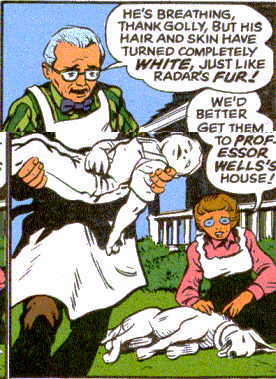
Illo #1 from Issue 42: Art by Rick Veitch
A flashback showing the origin of Supreme’s powers
Firstly, I should make it clear that Veitch’s contributions are confined to the art on short flashback strips or, in the latest issue (48), a series of faked-up comic-book covers which closely resemble Silver Age Justice Leagues. Otherwise we have a present-day narrative drawn very much in the Image/Liefeld style, featuring Liefeld’s own Superman rip-off, the red-caped, invulnerable, near-anagrammatic (and decidedly third-rate) hero, Supreme. But don’t let that put you off. If you haven’t got the originals, I advise you to snap up the current reprint editions (or wait for the trade paperback which 1 hope will follow), because this is very good stuff indeed.
Moore begins in 41 with Supreme returning to Earth from space, only to find that the planet is apparently phasing in and out with a second version of itself. Confronted by black, female and Mighty Mouse-style versions of himself, Supreme finds out that he has been caught up in a “flickering”, an unstable dimensional state which precedes a “revision”. He is transported to a Heaven-like dimension where all the previous versions of himself (including spin-offs like female cousins, Superpets, etc) now live on, despite having been discarded from reality (i.e. comicbook continuity).
Illo #2 from Issue 41: Art by Joe Bennett and Norm Rapmund
The New Supreme meets some previous versions
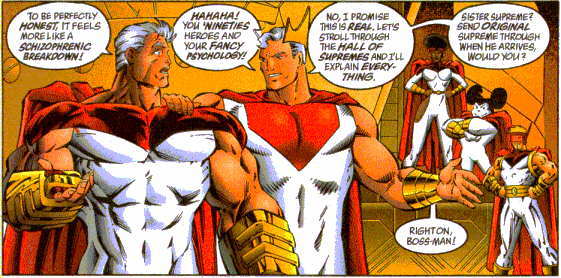
If this rings bells, especially with readers of Moore’s British work of long ago, it’s because he did something fairly similar with Captain Britain meeting his other-dimensional counterparts, but this is a different category of story. The old versions of Supreme go right back to his pre-WW2 original, when he could not fly but only leap tall buildings at a single bound. Clearly, then, we are dealing with something which goes back further than the 1993 origins of Liefeld’s character. Moore cuts through the layers of rip-off and homage, and leaves us in little doubt; this is the story of the original template superhero himself. It may be called Supreme: The New Adventures, but this comic is actually about Superman.
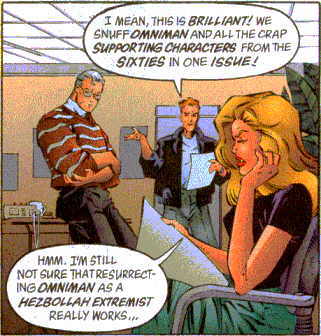
Illo #3 from Issue 43: Art by Joe Bennett and Norm Rapmund
On the left: Ethan Crane, Supreme’s secret identify
In the background: the gritty-and-ghastly British writer Billy Friday
So was Rick Veitch’s Maximortal, and like that title, Moore’s book includes some satire at the expense of the comics industry itself; in his secret identity, Supreme works as a superhero artist. His writer, Billy Friday, is a British figure who embodies the worst excesses of the post-1986 (and post-modern) neo-gritty realism school, which does provoke a few good laughs. (Friday is also going to be a major plot element, I suspect, after getting trapped in another dimension in Issue 45.) However, unlike Maximortal, this is not a hateful indictment of the comics industry; nor is it such an uncomfortable, deep, or complex probing of the superhero-as-power-fantasy. Moore’s game seems to be more to do with following the prototype superhero through his history since 1938, exploring with intelligence, insight and above all wit the different meanings Superman and his offspring have had over the years.
Following his experience in Comic Hero Limbo, the new “avatar” of Supreme returns to earth, where he finds that his memories of his own past are very vague. He seeks out souvenirs like old photos or the sight of Littlehaven, the town where he grew up, which trigger off flashbacks, drawn by Veitch in something near the appropriate art style. So we see his Golden Age origin in 42, his superdog’s origin, a story of his Supergirl figure, Suprema, in 46 (inked by Jim Mooney, fanboy!) etc.
Far and away the best of these gentle parodies comes in 44 when Supreme meets up with the Allied Supermen of America. They look back on their last Golden Age adventure together, when they were tormented with weird visions by characters strangely similar to the EC “horror hosts”. This leads to three short flashbacks, a la Weird Science, Shock Suspense, and finally Mad(a story derived largely from Mad�s Superman parody “Superduperman”). There is a point to all this; the superheroes were on their way out as the 50s dawned, superseded by SF, horror and the satire boom. One of the villains in the flashback taunts them with this; the simple answers which superheroes offered readers are no longer enough. America is now afraid of its own children and the atom bomb, and Supreme and his pals cannot reassure them any more. With the Madstory comes the final insult; America is actually daring to laugh at its superheroes.
Illo #4 from Issue 44: Art by Rick Veitch and Bill Wray
From the Mad-style flashback
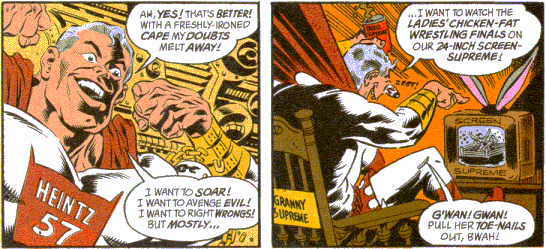
Meanwhile the Billy Friday plotline gathers pace in 45 as, exposed to Kryptonite-like Supremium, he mutates into a fractally complex and exponentially growing monster. One of Supreme’s robot doubles explains to our hero, “He’s becoming... just a huge, sprawling ungainly mass!” “Well, he’s a British comic-book writer,” replies Supreme, “His reaction [to Supremium] may be predisposed by occupational factors” In 47 Supreme meets up with the Batman of his world, Professor Night, in a flashback story parodying World’s Finest. We are introduced to the Prof�s “ultra-modern” crime-solving computer which can “deliver dozens of facts in minutes” (on ticker-tape, natch!); a brilliant evocation of the difference between the Silver Age and the post-PC world. (That’s PC as in Personal Computer rather than Political Correctness, though given DC’s 60s penchant for covers with Batgirl unable to fight because her tights were laddered etc., it could equally will apply!)
Finally, in 48 we find Supreme, on the trail of an old villain, entering a realm of pure ideas. This would be an appropriate setting for our hero to discover the truth about his existence, i.e. he’s a character in a comic book. (The other Supremes in Limbo have some crazed theories to explain the Revisions, but none of them come anywhere the truth as we readers know it). However, this would seem too close to Grant Morrison’s Animal Man finale for Moore to use a similar storyline now.
Illo #5 from Issue 48: Art by Mark Pajarillo and Norm Rapamund
Supreme and the Allies in the realm of pure ideas
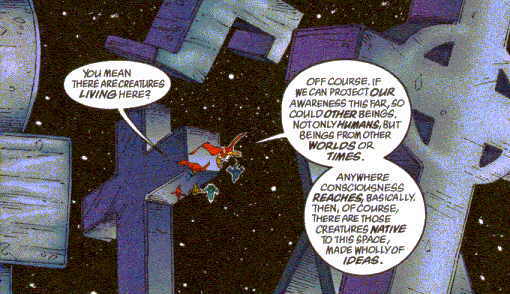
It must be possible to enjoy Supreme: The New Adventures without constantly relating it back to Superman; given the youth of Liefeld’s core market, I’m sure thousands of readers are doing just that. Both the present-day and flashback storylines are full of imaginative and funny moments in their own rights. Though the ideas would gain more resonance if they were being applied to the Real Thing, we must accept that such a radical take on Superman would never be acceptable in his own books. Publisher Rob Liefeld pushes the envelope of the medium again!
In the last few issues, the original brilliance of the series has dulled down a bit, maybe because Moore is hard at work on the forthcoming revamp of the Liefeld/Maximum Press universe, or partly because the novelty has simply worn off. Still, Supreme remains one of the best monthly reads around. Alan Moore has said for years that he is fed up with the post-modern grim’n’gritty superheroes which his own success with Swamp Thing and Watchmen helped to foist on us. He has also, more disappointingly, said that superhero stories should be intrinsically stupid and not try to take on social or political issues (though he broke his own rule when he wrote the first half of his WildCATS run for Image). Many other writers, and readers for that matter, clearly agree with him; hence the success of the “kinder, gentler” superhero comics like Flash, Impulse, Batman & Robin Adventures and the overt Silver and Golden Age copyists like Big Bang Comics.
Though such comics may muster a variable amount of more-or-less naive charm, they do not in my opinion come close to what Moore has achieved on Supreme. He has found a way of writing a kinder, gentler superhero yarn which retains intelligence, humour, pathos and that old cliché (far easier to pay lip service to than to provide), “a sense of wonder”. Morrison and Millar also had a brave stab at it with the somewhat darker Aztek, which sadly failed to catch on with a big public; Supreme has been selling by the truckload. The fact that it is also a guided tour through the history of Superman is both an intrinsic part of its success and an extra level of amusement. Better than 1963? Hmm ... let’s see if Moore can give it an ending before trying to make that judgement. Meanwhile, fun for all the family; even that strange uncle who sits in the corner muttering bitterly to himself, talks back at the television, and still expects his superhero comics to show signs of brain activity.
|
|
|
|
|
|